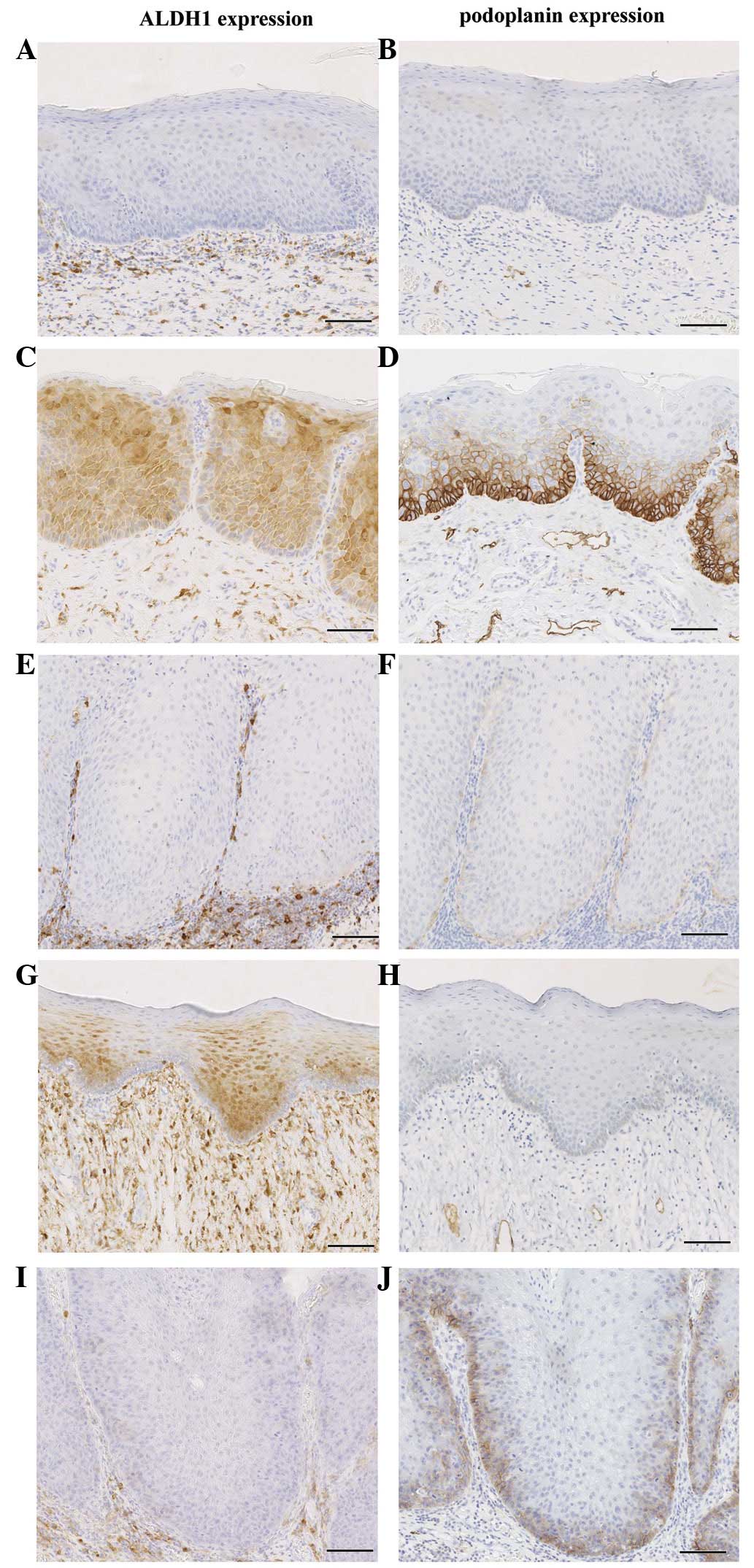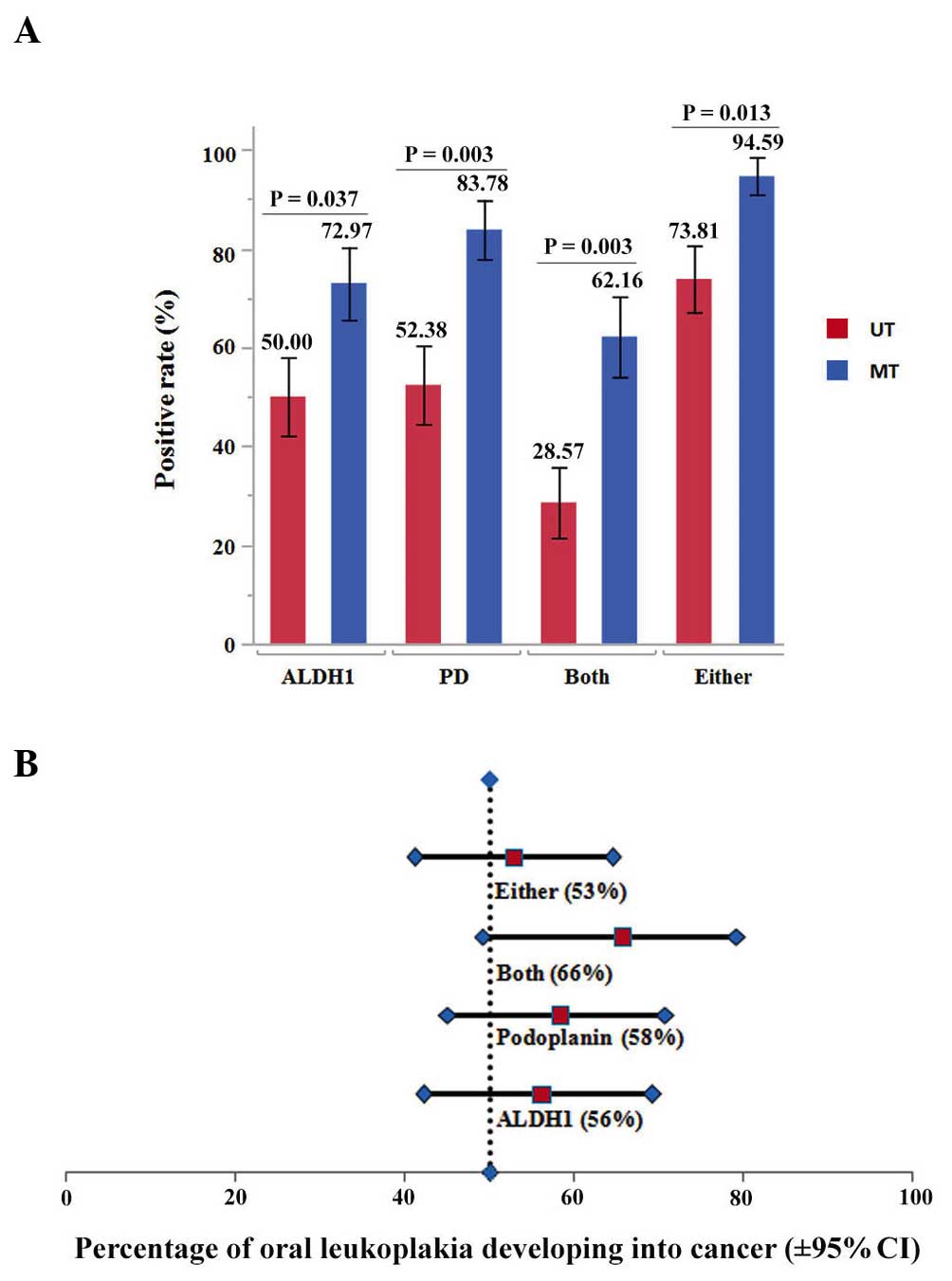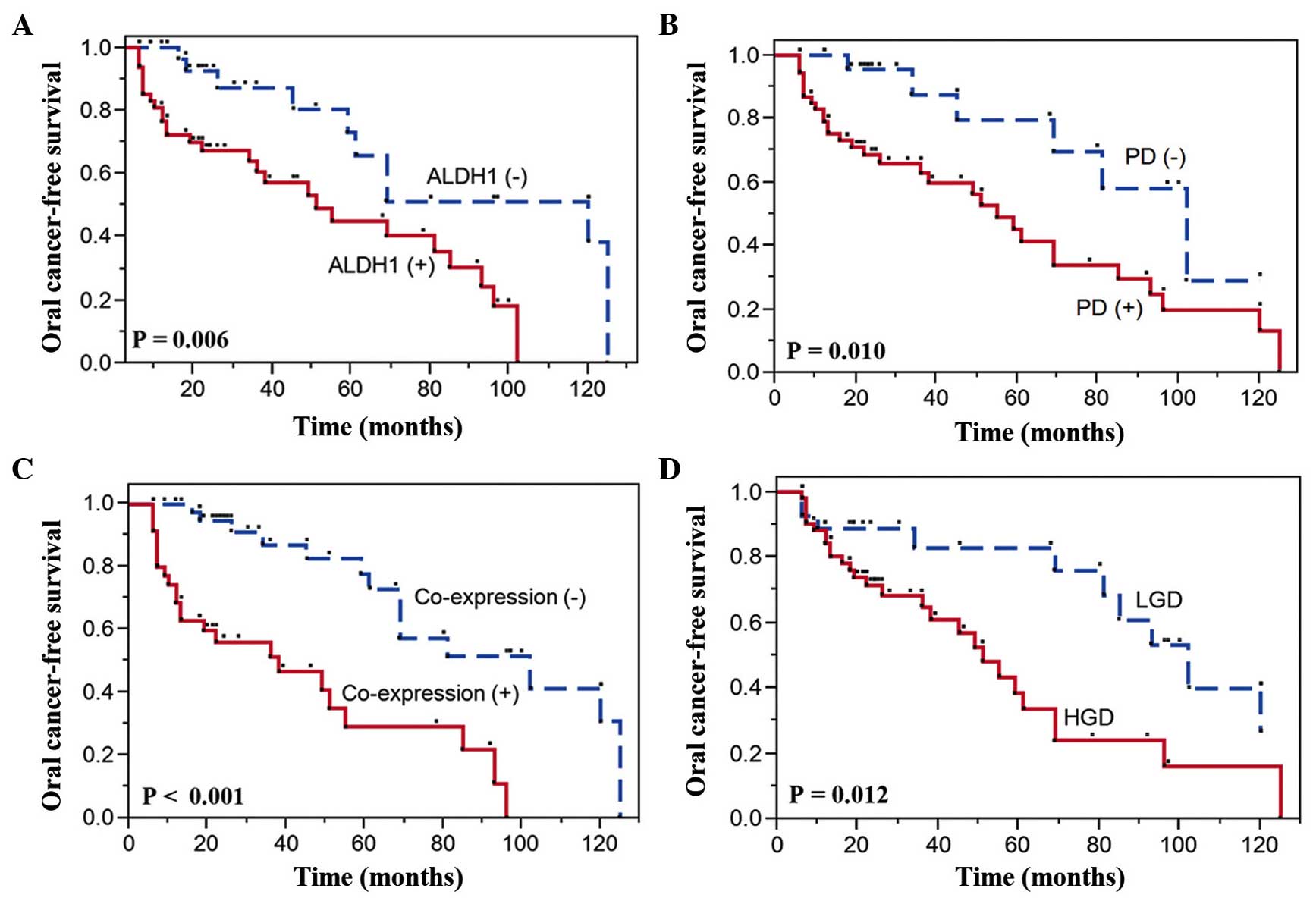|
1
|
Zini A, Czerninski R and Sgan-Cohen HD:
Oral cancer over four decades: Epidemiology, trends, histology, and
survival by anatomical sites. J Oral Pathol Med. 39:299–305. 2010.
View Article : Google Scholar : PubMed/NCBI
|
|
2
|
Ganly I, Patel S and Shah J: Early stage
squamous cell cancer of the oral tongue-clinicopathologic features
affecting outcome. Cancer. 118:101–111. 2012. View Article : Google Scholar : PubMed/NCBI
|
|
3
|
Warnakulasuriya S: Living with oral
cancer: Epidemiology with particular reference to prevalence and
life-style changes that influence survival. Oral Oncol. 46:407–410.
2010. View Article : Google Scholar : PubMed/NCBI
|
|
4
|
Papadimitrakopoulou VA, Hong WK, Lee JS,
Martin JW, Lee JJ, Batsakis JG and Lippan SM: Low-dose isotretinoin
versus beta-carotene to prevent oral carcinogenesis: Long-term
follow-up. J Natl Cancer Inst. 89:257–258. 1997. View Article : Google Scholar : PubMed/NCBI
|
|
5
|
Silverman S Jr, Gorsky M and Lozada F:
Oral leukoplakia and malignant transformation. A follow-up study of
257 patients. Cancer. 53:563–568. 1984. View Article : Google Scholar : PubMed/NCBI
|
|
6
|
Lee JJ, Hong WK, Hittelman WN, Mao L,
Lotan R, Shin DM, Benner SE, Xu XC, Lee JS, Papadimitrakopoulou VM,
et al: Predicting cancer development in oral leukoplakia: Ten years
of translational research. Clin Cancer Res. 6:1702–1710.
2000.PubMed/NCBI
|
|
7
|
Sayed SI, Dwivedi RC, Katna R, Garg A,
Pathak KA, Nutting CM, Rhys-Evans P, Harrington KJ and Kazi R:
Implications of understanding cancer stem cell (CSC) biology in
head and neck squamous cell cancer. Oral Oncol. 47:237–243. 2011.
View Article : Google Scholar : PubMed/NCBI
|
|
8
|
Zhang Z, Filho MS and Nör JE: The biology
of head and neck cancer stem cells. Oral Oncol. 48:1–9. 2012.
View Article : Google Scholar : PubMed/NCBI
|
|
9
|
Krishnamurthy S and Nör JE: Head and neck
cancer stem cells. J Dent Res. 91:334–340. 2012. View Article : Google Scholar : PubMed/NCBI
|
|
10
|
Gires O: Lessons from common markers of
tumor-initiating cells in solid cancers. Cell Mol Life Sci.
68:4009–4022. 2011. View Article : Google Scholar : PubMed/NCBI
|
|
11
|
Chen YC, Chen YW, Hsu HS, Tseng LM, Huang
PI, Lu KH, Chen DT, Tai LK, Yung MC, Chang SC, et al: Aldehyde
dehydrogenase 1 is a putative marker for cancer stem cells in head
and neck squamous cancer. Biochem Biophys Res Commun. 385:307–313.
2009. View Article : Google Scholar : PubMed/NCBI
|
|
12
|
Wicki A and Christofori G: The potential
role of podoplanin in tumor invasion. Br J Cancer. 96:1–5. 2007.
View Article : Google Scholar : PubMed/NCBI
|
|
13
|
Marcato P, Dean CA, Giacomantonio CA and
Lee PW: Aldehyde dehydrogenase: Its role as a cancer stem cell
marker comes down to the specific isoform. Cell Cycle.
10:1378–1384. 2011. View Article : Google Scholar : PubMed/NCBI
|
|
14
|
Clay MR, Tabor M, Owen JH, Carev TE,
Bradford CR, Golf GT, Wicha MS and Prince ME: Single-marker
identification of head and neck squamous cell carcinoma cancer stem
cells with aldehyde dehydrogenase. Head Neck. 32:1195–1201. 2010.
View Article : Google Scholar : PubMed/NCBI
|
|
15
|
Chen YC, Chang CJ, Hsu HS, Chen YW, Tai
LK, Tseng LM, Chiou GY, Chang SC, Kao SY, Chiou SH and Lo WL:
Inhibition of tumorigenicity and enhancement of
radiochemosensitivity in head and neck squamous cell cancer-derived
ALDH1-positive cells by knockdown of Bmi-1. Oral Oncol. 46:158–165.
2010. View Article : Google Scholar : PubMed/NCBI
|
|
16
|
Chen C, Wei Y, Hummel M, Hoffmann TK,
Gross M, Kaufmann AM and Albers AE: Evidence for
epithelial-mesenchymal transition in cancer stem cells of head and
neck squamous cell carcinoma. PLoS One. 6:e164662011. View Article : Google Scholar : PubMed/NCBI
|
|
17
|
Liu W, Wu L, Shen XM, Shi LJ, Zhang CP, Xu
LQ and Zhou ZT: Expression patterns of cancer stem cell markers
ALDH1 and CD133 correlate with a high risk of malignant
transformation of oral leukoplakia. Int J Cancer. 132:868–874.
2013. View Article : Google Scholar : PubMed/NCBI
|
|
18
|
Visus C, Ito D, Amoscato A,
Macieiewska-Franczak M, Abdelsalem A, Dhir R, Shin DM, Donnenbera
VS, Whiteside TL and DeLeo AB: Identification of human aldehyde
dehydrogenase 1 family member A1 as a novel CD8+ T-cell-defined
tumor antigen in squamous cell carcinoma of the head and neck.
Cancer Res. 67:10538–10545. 2007. View Article : Google Scholar : PubMed/NCBI
|
|
19
|
Chen YW, Chen KH, Huang PI, Chen YC, Chiou
GY, Lo WL, Tseng LM, Hsu HS, Chang KW and Chiou SH: Cucurbitacin I
suppressed stem-like property and enhanced radiation-induced
apoptosis in head and neck squamous carcinoma-derived CD44(+)
ALDH1(+) cells. Mol Cancer Ther. 9:2879–2892. 2010. View Article : Google Scholar : PubMed/NCBI
|
|
20
|
Luo WR, Gao F, Li SY and Yao KT: Tumor
budding and the expression of cancer stem cell marker aldehyde
dehydrogenase 1 in nasopharyngeal carcinoma. Histopathology.
61:1072–1081. 2012. View Article : Google Scholar : PubMed/NCBI
|
|
21
|
Deng S, Yang X, Lassus H, Liang S, Kaur S,
Ye Q, Li C, Wang LP, Roby KF, Orsulic S, et al: Distinct expression
levels and patterns of stem cell marker, aldehyde dehydrogenase
isoform 1 (ALDH1), in human epithelial cancers. PLoS One.
5:e102772010. View Article : Google Scholar : PubMed/NCBI
|
|
22
|
Kahn HJ and Marks A: A new monoclonal
antibody, D2-40, for detection of lymphatic invasion in primary
tumors. Lab Invest. 82:1255–1257. 2002. View Article : Google Scholar : PubMed/NCBI
|
|
23
|
Yuan P, Temam S, El-Naggar A, Zhou X, Liu
DD, Lee JJ and Mao L: Over expression of podoplanin in oral cancer
and its association with poor clinical outcome. Cancer.
107:563–569. 2006. View Article : Google Scholar : PubMed/NCBI
|
|
24
|
Shi P, Liu W, Zhou ZT, He QB and Jiang WW:
Podoplanin and ABCG2: Malignant transformation risk markers for
oral lichen planus. Cancer Epidemiol Biomarkers Prev. 19:844–849.
2010. View Article : Google Scholar : PubMed/NCBI
|
|
25
|
Saintigny P, El-Naggar AK,
Papadimitrakopoulou V, Ren H, Fan YH, Feng L, Lee JJ, Kim ES, Hong
WK, Lippman SM and Mao L: DeltaNp63 over expression, alone and in
combination with other biomarkers, predicts the development of oral
cancer in patients with leukoplakia. Clin Cancer Res. 15:6284–6291.
2009. View Article : Google Scholar : PubMed/NCBI
|
|
26
|
Kawaguchi H, El-Naggar AK,
Papadimitrakopoulou V, Ren H, Fan YH, Feng L, Lee JJ, Kim E, Hong
WK, Lippman SM and Mao L: Podoplanin: A novel marker for oral
cancer risk in patients with oral premalignancy. J Clin Oncol.
26:354–360. 2008. View Article : Google Scholar : PubMed/NCBI
|
|
27
|
Pindborg JJ, Reichart PA, Smith CJ and Van
der Waal I: Histological Typing of Cancer and Precancer of the Oral
Mucosa. World Health Organization. Springer; Berlin: pp. 25–26.
1997
|
|
28
|
Habiba U, Kitamura T, Yanagawa-Matsuda A,
Hida K, Higashno F, Ohiro Y and Shindoh M: Cytoplasmic expression
of HuR may be a valuable diagnostic tool for determining the
potential for malignant transformation of oral verrucous borderline
lesions. Oncol Rep. 31:1547–1554. 2014.PubMed/NCBI
|
|
29
|
Braakhuis BJ, Leemans CR and Brakenhoff
RH: A genetic progression model of oral cancer: Current evidence
and clinical implications. J Oral Patho Med. 33:317–322. 2004.
View Article : Google Scholar
|
|
30
|
Wu A, Luo W, Zhang Q, Yang Z, Zhang G, Li
S and Yao K: Aldehyde dehydrogenase 1, a functional marker for
identifying cancer stem cells in human nasopharyngeal carcinoma.
Cancer Lett. 330:181–189. 2013. View Article : Google Scholar : PubMed/NCBI
|
|
31
|
Inoue H, Miyazaki Y, Kikuchi K, Yoshida N,
Ide F, Ohmori Y, Tomomura A, Sakashita H and Kusama K: Podoplanin
expression during dysplasia-carcinoma sequence in the oral cavity.
Tumor Biol. 33:181–194. 2012. View Article : Google Scholar
|
|
32
|
Holmstrup P, Vedtofte P, Reibel J and
Stoltze K: Long term treatment outcome of oral premalignant
lesions. Oral Oncol. 42:461–474. 2006. View Article : Google Scholar : PubMed/NCBI
|
|
33
|
de Vicente J Carlos, Palbo J Rodrigo,
Santamarta-Rodriguez T, Lequerica-Fernández P, Allonca E and
García-Pedrero JM: Podoplanin expression in oral leukoplakia:
Tumorigenic role. Oral Oncol. 49:598–603. 2013. View Article : Google Scholar : PubMed/NCBI
|

















